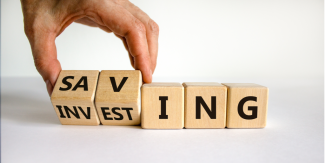
Reimagining the Emergency Fund
Crack open any personal finance book and right there on page one, chapter one, you’ll see a statement that says something along the lines of:
“It is recommended that individuals keep 3-6 months of income in an emergency fund.”
Without further context or personalized advice, many people (including Dave Ramsey) preach that dual-income households must keep at least three months of their take-home income (six months for single-income households) stored safely away in a bank savings account (currently earning 0.02% annual yield), waiting for an emergency that may never occur.
Granted, the primary purpose of an emergency fund is not to seek investment gains. Saving for emergencies and unexpected job loss are crucial to building and maintaining a strong financial base; the pandemic has certainly taught us that. However, in this interest rate environment, you should seek to implement a strategy that will at least allow you to keep up with inflation and better prioritize your savings for long-term financial success.
It’s important to note that the following recommendations are very broad. No two situations are the same, and your optimal plan may not look like this. However, everybody starts somewhere; so let’s take a look at where you should, or at least could, be better saving your money to your advantage.
- Regardless of your emergency savings or debt levels, if your employer offers a 401(k) match, take it. This guarantees you an automatic 100% return on your money and there is simply no excuse for not to taking advantage of free money. Invest in accordance with your projected retirement date. Target date retirement funds work great for this purpose.
- Pay off any high interest credit card debt you’re holding. Yes. Even before you establish an emergency fund. Maintaining high-interest credit card debt guarantees a dollar-for-dollar loss on your money because of interest accumulation. It’s like allowing yourself to experience a micro emergency expense every month without even encountering an emergency! Make a plan now to pay balances off as quickly as you can, and if an emergency does come before you’ve had a chance to build up your emergency fund, at least you can use any freed-up credit to cover the expense in a pinch.
- Next, you do need to establish a small emergency fund to cover unforeseen expenses like your car breaking down. I recommend starting by establishing a Roth IRA with an online broker, such as: Vanguard, Charles Schwab, Fidelity, or Betterment. Roth IRAs are unique in that because you have already paid taxes on money contributed, you can always take out your contribution amounts penalty-free. This is a great way to keep your savings accessible for short-term emergencies while simultaneously working toward a long-term savings goal. Begin by investing it conservatively, with mostly short-term fixed income ETF securities likely to earn between 2% and 3%.
- If you have dependents or are the primary income earner in your household, it is very important that you next purchase a term life insurance policy, as well as disability insurance. While an emergency fund may be sufficient to cover your needs for a few months in the event of job loss, it will be insufficient to cover the needs of your dependents in the event of your disability or death. If you don’t have a life insurance option through your employer, we can help you get connected to a low-cost provider.
- Max out your Health Savings Account (HSA), if eligible. I harp on these A LOT because they are the only triple-tax-advantageous accounts (tax deduction going in, tax-free investment growth, and tax-free withdrawal when used for qualifying medical expenses). It might not be possible right away, but the true tax advantage of HSAs come through long-term investment for retirement health expenses such as Medicare supplemental and long-term care down the road.
- Once you’ve maxed out your HSA, it’s now time to max out the Roth IRA you established in step 3. Currently, individuals can contribute $6,000 per year (that’s $500/month) in after tax money. Bonus! Roth IRA funds can also be used to cover the down payment on your first house.
- Once you’ve maxed out your Roth IRA, it’s now time to establish a taxable (“savings plus”) investment account that will replace your Roth IRA as your emergency fund. You can now begin to invest your Roth IRA and HSA a little more aggressively, knowing that emergency spending needs will be paid out of this account instead.
- It’s at this point that, you should consider purchasing your residence. Mortgage rates are the lowest they have ever been, and federal FHA programs allow for down payment amounts as low as 3.5%. Owning your home can serve as an important source of wealth building and the equity--an additional emergency fund source; however, it’s important that you first have sufficient emergency savings established, since you will now be on the hook for your own repairs and maintenance surprises.
- Next, I generally recommend paying off any remaining student loan or other debts that carry an interest rate of over 5%. The most important factor to consider when deciding whether to “invest more” or pay off debt is the interest rate. If the interest rate on your outstanding debt is higher than a reliable rate of return on your investments, then you should prioritize paying off the debt before putting more money toward investing.
- Once you have a baseline emergency fund established and your high-interest debts paid, you should then consider aggressively increasing your contributions to your employer 401(k) or similar plan, beyond just what is necessary to get the match. Contribution limits for 401(k) plans are much higher than for IRAs and carry no income limitations. Begin aggressively upping your contributions up to the annual limit (currently $19,500 for 2021 and an additional $6,500 for those over 50). Roth 401ks can be especially powerful savings engines for those with access to them.
- After securing your retirement, you may look to begin saving for education expenses through a 529 Plan if you have children. 529 Plan contributions are made on an after-tax basis, but many states, including Oklahoma, offer a state tax deduction.
- Finally, you can look to begin adding to your taxable savings plus investment account beyond just what you need for emergency savings. This account can begin to serve many purposes, such as allowing you to purchase a car with cash, paying all medical expenses out of pocket, home renovations, saving for vacations, and (if you must) engaging in speculative individual stock or crypto trading.
If you’ve made it this far, you have no high interest debts, you are adequately insured against death or disability, you are maxing out your HSA, employer 401k, Roth IRA, and you have sufficient emergency savings in case of unexpected job loss. Congratulations! It’s also the time that you need to hire a fiduciary financial advisor, like Radix Financial, if you haven’t already.
A few other questions you might have while reading this…
How much do I really need to save for emergencies?
Here are a few factors that could impact how much you need to keep on hand that make sense for you and your family’s unique situation:
- What is the level of stability in your job? What is the demand for employees in your industry? What is the typical length of notice for terminations? In some professions, a 2 weeks-notice is standard. In others, such as academia, notice of termination could come as early as a full academic year prior to the end of employment. Job stability, turnover, demand, and notice length can all impact how large your emergency fund needs to be, based on how quickly you think you could find another source of comparable employment.
- What percentage of your take-home pay is needed for essential expenses vs. discretionary spending or savings? Saving 3-6 months of take-home pay may look very different than keeping enough money to last you 3-6 months on a bare-bones budget. You may need less than you think!
- Do you have access to family support? In a worst-case scenario, could you move back in with your parents? Or borrow a family vehicle? Or utilize a family member for childcare? Each of these supports could reduce the amount of funds needed in the event of an emergency or job loss situation.
Should I pay off my home mortgage?
In the current interest rate environment, I don’t recommend it, although it may make sense to refinance to a lower rate. Instead, send extra cash flow into long-term investments where the rate of return would be expected to outpace your low-rate mortgage. Not to mention, your mortgage interest payments are tax deductible!
Can’t I just skip all this and trade crypto?
I read today, that there is a hamster named Mr. Boxx that directs crypto buying and selling decisions based on his activities. Since June, Mr. Boxx has outperformed the S&P 500, Warren Buffett, and the ARKK Innovation fund with a 20% return. So easy a hamster can do it!
Anytime making money seems “too easy” warning sirens should go off in your head. Trading crypto, meme stocks, gold, or any other asset with very little proven intrinsic value or use is essentially involving yourself in a complex pyramid scheme. The pyramid is dependent only on getting more people to buy in and nothing else. Eventually you run out of new buyers, price growth stagnates, and fear causes the pyramid to quickly collapse.[1]
I don’t personally or professionally recommend it, but if you feel you must trade in crypto, make sure you’ve made it to step 12 first.
What about rental property?
I’m all for owning your house. You’ve got to live somewhere, so you might as well pay yourself for the privilege. However, rental property is less like an investment, and more like running your own business. Rates of return are highly dependent on your location, but historically rental property has appreciated at a similar rate to low-cost index stock funds, but without the 6% realtor fee, the leasing headache, the maintenance cost, the taxes, the insurance, and the frequent need to renovate.
Hope this has been helpful! If you have other questions or need help getting started, don't hesitate to reach out to amy@radixfinancial.com.
[1] https://blogs.cfainstitute.org/investor/2018/11/08/bitcoin-cryptocurrenc...

